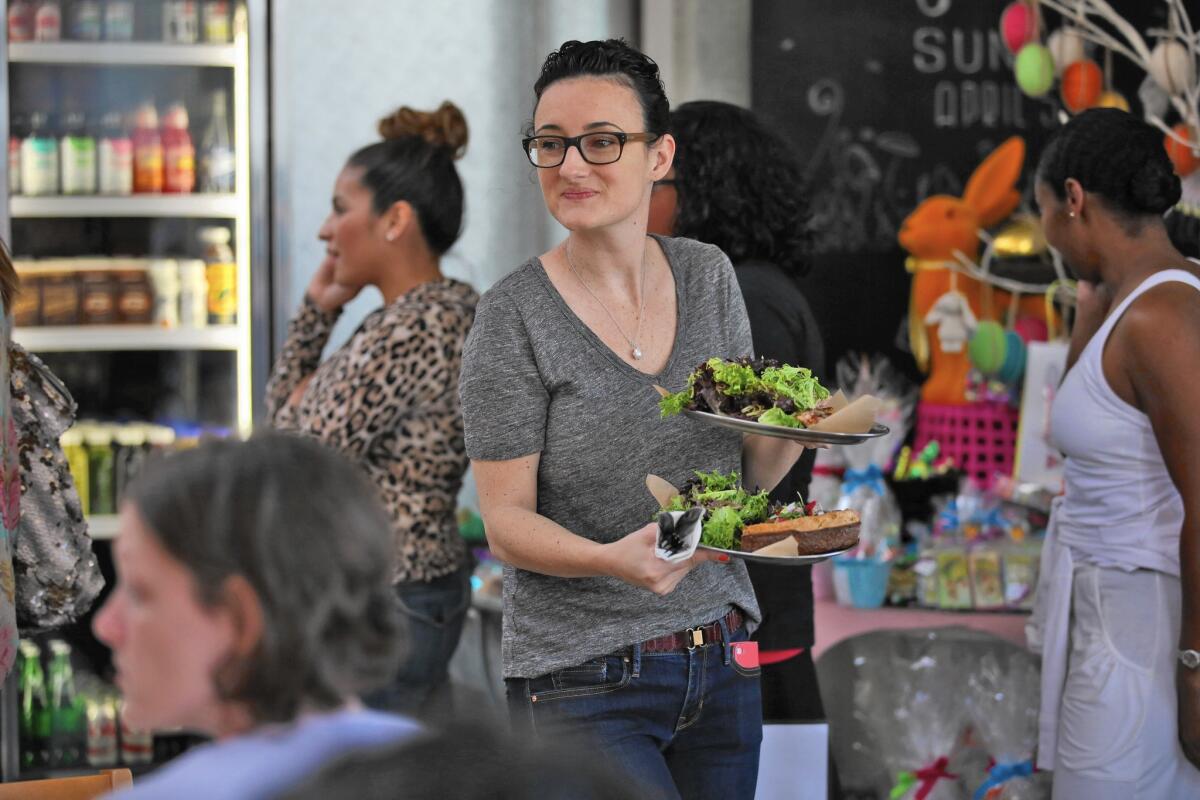In a changing Pasadena neighborhood, a ‘Gentrification Conversation’

- Share via
Alfredo Resendiz realized change had come to his part of Pasadena while standing in a long line at a newly opened restaurant.
“I looked around and thought: ‘There are a lot of white people in this place,’” he said.
It was an observation, not a complaint.
The stretch of Lincoln Avenue in northwest Pasadena near the Altadena border had needed new blood for years. Still, it seemed surreal to see people packing a place — on a block that locals had written off — to order $12 sandwiches, farro bowls and duck confit.
“People look at Lincoln as the ‘hood of Pasadena,” Resendiz said. “It’s not a place you’d expect a trendy restaurant.”
Lincoln restaurant owner Christine Moore — who also runs the popular Little Flower Candy Shop in a more upscale part of town — set up here last fall because the building fit her needs and her budget. She spent a year rehabbing the former machine shop, which had been empty for so long it was due to be demolished.
She’s no carpetbagger: Moore, who is white, has lived in Pasadena for 30 years. Still, her success on Lincoln makes the threat of gentrification feel very real. And that makes people uneasy, in a neighborhood that was for decades primarily black and is now comfortably black and Latino.
“I’ve been there four or five times,” said Resendiz, who is Latino. “Ninety percent of the customers are people that don’t look like me or my friends — which isn’t a bad thing. I can’t be mad at anybody who wants to come in and develop the community and bring us things we haven’t had in a while.”
His philosophy is simple: “The community has open arms, but you’ve got to hug us back.”
::
Resendiz, 38, grew up here and once taught English at Muir High, a block from the restaurant. He’s seen efforts to revive the Lincoln Corridor sputter over the years because “people didn’t want to take risks.”
He doesn’t want fear and resentment over this next wave of change to divide the community, so he’s pushing for the kind of public discussion that other neighborhoods tend to avoid.
In January, he hosted a “Gentrification Conversation” at Perry’s Joint, a black-owned sandwich shop that’s been a mainstay on Lincoln for more than a decade. About 75 people showed up: young and old, black and white, newcomer and native. “I wanted to create an environment where we would get some honesty and be respectful of both sides,” Resendiz said.
Everyone was painstakingly polite. Moore showed up and cast her lot with residents. She’s single, running a business and raising three children. Every speaker seemed to offer up a local pedigree: My family moved here in 1929. I’ve lived in the same house since 1953. I’ve been here for 30 years.
Some residents are struggling to figure out where they fit in this community evolution — like the white woman who bought her home in a mostly black neighborhood 12 years ago because, at the height of the real estate market, it was all she could afford.
“I don’t know if that makes me a gentrifier or not,” she told the crowd. Then she proceeded to complain about new neighbors “who don’t give you the time of day” and “don’t like the community.”
She is not one of them. They are the people that old-timers resent: Homebuyers hunting for bargains, who like the price but not the neighborhood. They’ll move in and aim to fix it up, with bike lanes, boutiques and a Trader Joe’s in place of the Super King.
“Displacement is the biggest concern,” Resendiz said. “The other worry is loss of culture, though no one can really identify it past that phrase. Is it music, food, language?
“You just know you feel different when you see a white woman walking a dog in the neighborhood at 9:30 at night. Something has changed. Is that a loss of culture or is it just safe streets?
“And what happens when it’s a black kid walking up Lincoln wearing a hoodie at 9:30? He’s just going to McDonald’s. Is she afraid of him?”
::
Gentrification is more about money than it is about skin color.
Race is, early on, its most obvious dimension. But the residents I talked with this week seemed most worried about the mind-set of newcomers.
“I used to be that crazy white chick down the street,” said Anne Louise Bannon, whose family moved to Altadena 17 years ago. “Now I’m not the only one.”
Her neighborhood today is a mix of black, white and Latino, and its live-and-let-live vibe binds what race might divide. Her neighbor doesn’t complain about her wandering chickens; she doesn’t ask him to lower the volume on his booming rap music.
There are plenty of gaps that need bridging in neighborhoods where suspicion is high, jobs are scarce and public schools are closing because of low enrollment. Resendiz is hosting another forum Saturday, and hoping the gloves come off and people talk about those issues.
“Our differences allow people to be standoffish,” he said. “We have to get past that.”
Already the public process seems to be having an effect.
“The conversation we’re having in our community makes me feel hopeful,” said Cushon Bell, who is black. She and her husband moved to Altadena in 2001, after gentrification put Silver Lake, where four generations of her family had lived, out of reach.
Several families have moved in since — none of them black — and housing prices in her neighborhood have more than doubled. “That impacts who can actually live here,” Bell said.
It’s also allowed her to see the issue from both sides. “The reality is,” she said, “nobody really wants somebody else to come in and take over.”
Twitter: @SandyBanksLAT
More to Read
Sign up for Essential California
The most important California stories and recommendations in your inbox every morning.
You may occasionally receive promotional content from the Los Angeles Times.











